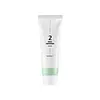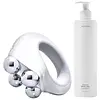What's inside
What's inside
 Key Ingredients
Key Ingredients

No key ingredients
 Benefits
Benefits

No benefits
 Concerns
Concerns

No concerns
 Ingredients Side-by-side
Ingredients Side-by-side

Water
Skin ConditioningGlycerin
HumectantButyrospermum Parkii Butter
Skin ConditioningCetearyl Alcohol
EmollientDipropylene Glycol
HumectantCaprylic/Capric Triglyceride
MaskingHydrogenated Poly(C6-14 Olefin)
EmollientMethyl Trimethicone
Skin ConditioningHydrogenated Polydecene
Emollient1,2-Hexanediol
Skin ConditioningCeramide NP
Skin ConditioningVegetable Oil
Skin ConditioningPhenyl Trimethicone
Skin ConditioningGlyceryl Stearate Se
EmulsifyingPalmitic Acid
EmollientLaminaria Japonica Extract
Skin ProtectingEclipta Prostrata Leaf Extract
Skin ConditioningCentella Asiatica Extract
CleansingAcmella Oleracea Extract
Skin ProtectingUlmus Davidiana Root Extract
Skin ConditioningAmaranthus Caudatus Seed Extract
Skin ConditioningAvena Sativa Kernel Extract
AbrasivePteris Multifida Extract
AntioxidantCynara Scolymus Leaf Extract
Skin ConditioningHydrogenated Lecithin
EmulsifyingSodium Hyaluronate
HumectantMacadamia Integrifolia Seed Oil
Skin ConditioningElaeis Guineensis Oil
EmollientAdansonia Digitata Seed Oil
EmollientPersea Gratissima Oil
Skin ConditioningCetearyl Olivate
Sorbitan Olivate
EmulsifyingStearic Acid
CleansingC12-16 Alcohols
EmollientBehenyl Alcohol
EmollientMicrocrystalline Cellulose
AbsorbentCetearyl Glucoside
EmulsifyingButylene Glycol
HumectantMethylpropanediol
SolventAmmonium Acryloyldimethyltaurate/Vp Copolymer
Glyceryl Polymethacrylate
Cellulose Gum
Emulsion StabilisingCholesterol
EmollientFructooligosaccharides
HumectantBeta-Glucan
Skin ConditioningDisodium EDTA
Polyquaternium-51
Skin ConditioningMyristic Acid
CleansingHydrolyzed Hyaluronic Acid
HumectantGlucose
HumectantPhytosphingosine
Skin ConditioningEthylhexylglycerin
Skin ConditioningWater, Glycerin, Butyrospermum Parkii Butter, Cetearyl Alcohol, Dipropylene Glycol, Caprylic/Capric Triglyceride, Hydrogenated Poly(C6-14 Olefin), Methyl Trimethicone, Hydrogenated Polydecene, 1,2-Hexanediol, Ceramide NP, Vegetable Oil, Phenyl Trimethicone, Glyceryl Stearate Se, Palmitic Acid, Laminaria Japonica Extract, Eclipta Prostrata Leaf Extract, Centella Asiatica Extract, Acmella Oleracea Extract, Ulmus Davidiana Root Extract, Amaranthus Caudatus Seed Extract, Avena Sativa Kernel Extract, Pteris Multifida Extract, Cynara Scolymus Leaf Extract, Hydrogenated Lecithin, Sodium Hyaluronate, Macadamia Integrifolia Seed Oil, Elaeis Guineensis Oil, Adansonia Digitata Seed Oil, Persea Gratissima Oil, Cetearyl Olivate, Sorbitan Olivate, Stearic Acid, C12-16 Alcohols, Behenyl Alcohol, Microcrystalline Cellulose, Cetearyl Glucoside, Butylene Glycol, Methylpropanediol, Ammonium Acryloyldimethyltaurate/Vp Copolymer, Glyceryl Polymethacrylate, Cellulose Gum, Cholesterol, Fructooligosaccharides, Beta-Glucan, Disodium EDTA, Polyquaternium-51, Myristic Acid, Hydrolyzed Hyaluronic Acid, Glucose, Phytosphingosine, Ethylhexylglycerin